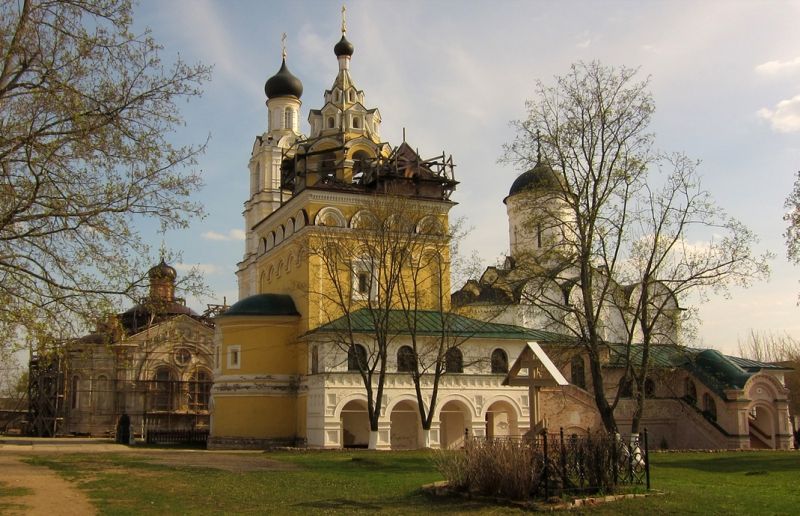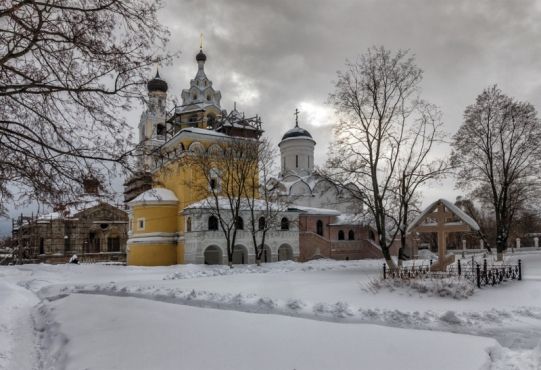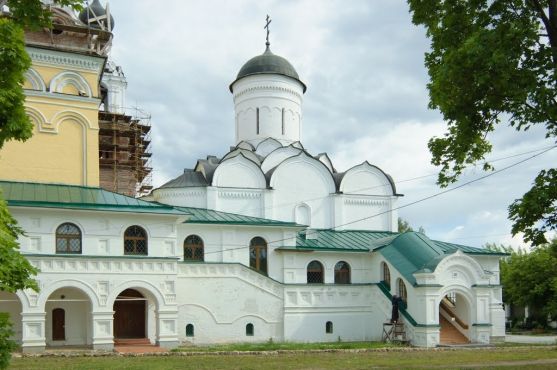Holy Annunciation Monastery
- Address:
- Kirzhach, Gagarin Street, 27
- GPS:
- 56.16186120, 38.86966776
- Phones:
- +7 (49237) 2-22-33
The Holy Annunciation Monastery plays such an important role in the life of Kirzhach that the very appearance of the city is associated with the founding of the monastery here in 1358. According to the chronicles of the Trinity-St. Sergius Lavra, in 1358 venerable Sergius of Radonezh left the Trinity Monastery founded by him, because of the reluctance to enter into a petty struggle for power with his elder brother Stefan. On the steep bank of the river Kirzhach, where there was a spring with pure water, Sergius with several monks of the Holy Trinity Monastery joining him built a wooden church, a well over the spring and founded a new monastery, thus giving birth to the future city. According to legend, Sergius spent four years in Kirzhach, and then returned to the Trinity Monastery. But he treated the Kirzhach monastery as the beloved offspring until the end of his life, and never interrupted his connection with it, controlling all its affairs. After himself, Sergius left a disciple Roman, who devoted his entire life to the construction and improvement of the Annunciation Monastery, where he was buried as his first hegumen. In 1980 he was canonized under the name of Roman Kirzhachsky.
Monastery, originally existed as a male one, was in charge of the Trinity- St. Sergius Lavra. The exact date of construction of the Annunciation Cathedral is unknown, but its architectural forms allow the building to be attributed to the beginning of the 16th century. It is a single-domed temple of a cubic form, standing on a basement. Each facade is divided by wide pilaster-strips into three keeled zakomars. At the base of the light drum with slit windows is a two-tiered octagon decorated with kokshniks, giving the temple solemnity and elegance. Outside, the cathedral has a covered gallery-promenade, surrounding it from three sides. The cathedral still draws attention by its proportionality and completeness of forms.
Archival documents show that the monastery was surrounded by a stone fence, beyond which on the north side there was a chapel above the well dug by Sergius of Radonezh. At the very beginning of the 21th century, in its place was built a new chapel, preserving the spring – the only remaining lifetime evidence of the activities of St. Sergius.
As the monastery developed in the place of impenetrable forests around it, villages and settlements appeared. Thanks to the glory of its founder, the Annunciation Monastery enjoyed great popularity and attention of Russian princes and boyars. They endowed it with lands and peasants, so that soon it became one of the richest monasteries of north-eastern Rus. By the middle of the 16th century, the Kirzhach Annunciation Monastery was the first among the 14 assigned monasteries of the Trinity-St. Sergius Lavra.
However, the life of the monastery was not cloudless. The friary with the nearby settlements often suffered disasters. It is known, for example, that in 1571 plague broke out, many villages on the Kirzhach land have died out. In 1598, the monastery suffered from a large fire and became poor. It became the place of exile from the Trinity-St. Sergius Lavra "monks who started idleness, ... to subdue." The monastery survived the devastation from the Polish-Lithuanian troops in 1609-1612.
In the 17th century, during the reign of Alexey Mikhailovich Romanov, the monastery recovered from the upheavals and flourished even more. This was promoted by the developed monastic economy (six water mills, two saltworks, etc.) and the patronage of eminent boyars. At their insistence, in 1668 Alexey Mikhailovich gave the monastery fees from five fairs held in Kirzhach.
In 1656, near the Cathedral of the Annunciation, a stone Church-belfry of the Savior was built with the money of the boyar Ivan Miloslavsky, in memory of his parents. Subsequently, in the basement of the temple, the family burial vault of the Miloslavskys was arranged.
A simple and clear quadrangle of the Savior Church is placed on a basement and instead of traditional heads is completed by a considerably smaller octagon of the tented bell-tower. This type of temple was called "church under the bells" and was in the 17th century quite rare and very interesting. The upper part of the facades along the entire perimeter is decorated with two tiers of frieze from relief kokoshniks, separated by a clearly marked profile. A special decorativeness to the temple is given by windows, lavishly framed with platbands in the form of side columns and keeled and triangular tops.
The Savior Church is connected to the Annunciation Cathedral by a gallery- promenade and makes a single whole with it, although almost a century divides the construction of two churches. This method was very rare in the Old Russian architecture, and the architects used it with great artistic taste.
Frescos and mosaics in the design of interiors, judging by the documentary descriptions, were performed by talented craftsmen. Famous Russian icon painter Fedor Ushakov, a pupil of Andrey Rublev, participated in the painting of the Savior Church.
1764 was truly tragic in the fate of the Annunciation Monastery: it was abolished by the Manifesto of Catherine II. The property and brothers of the monastery were attributed to the Trinity-St. Sergius Lavra, and the temples became parish. In view of the small number and poverty of the parishioners, they have been in decline for almost a century.
Only one notable event from this period remained in the history of the former monastery: in 1823, the ancient temples of the monastery were visited by Emperor Alexander I during his passage through Kirzhach. In memory of this visit, a gold plated silver dish with a monogram "AI", in which the townspeople presented the tsar with bread and salt, was kept in the sacristy of the Annunciation Cathedral.
In the middle of the 19th century, monastic churches were revived, thanks to the selfless efforts of the Kirzhach families, first of all, representatives of the Solovyovs' trading house. The head of the family A.P. Solovyov since 1844 for 17 years was the permanent headman of the Annunciation Cathedral. He studied at the Trinity-Sergius Lavra icon-painting and, together with his son Peter, painted the walls of the Annunciation Cathedral and the church of St. Sergius of Radonezh, for which he received thanks from the emperor and the blessing of the Holy Synod. It was the skills of church painting that later allowed Peter Solovyov to earn money drawing patterns on fabrics produced in Bogorodsky district, and in 1849 – to establish the production of silk fabrics in Kirzhach itself. After the death of A.P. Solovyov, the care of the churches continued his eldest son Alexander Soloviev.
In the years 1864-1869, A.A. and P.A. Solovyovs erected a majestic temple in honor of All Saints with a high five-tiered bell tower near the grave of their parents. They also donated expensive church utensils, and a large bell weighing 500 poods on the belfry.
Unfortunately, in Soviet times the temple was used as a public canteen, then – as a bakery, and until the 1990's – as a bakery factory. Therefore, today it is in a deplorable state. It requires large financial investments for its restoration.
Until the early 1960's, in the ancient monastery there was desolation and devastation. In the years 1963-1964, the Annunciation Cathedral and the Church of the Savior were partially restored. In 1990, both churches were returned to the Russian Orthodox Church. In July 1995, the Holy Annunciation Monastery was resumed, but already as a convent.
Since 2005, spiritual-religious and historical-regional studies have been held annually in the city, dedicated to the founders of Kirzhach – Sergius of Radonezh and Roman Kirzhachsky (Romanov's readings). The active participation in the readings is taken by the servants of the church, local historians, workers of culture and education, students.
 Tourism portal of the
Tourism portal of the

